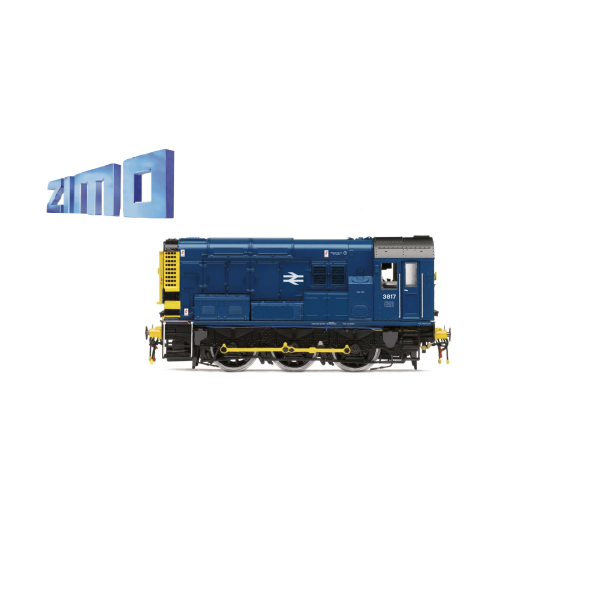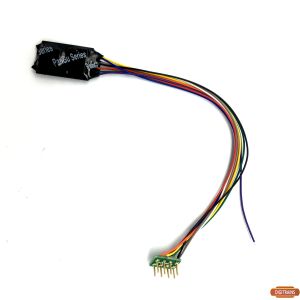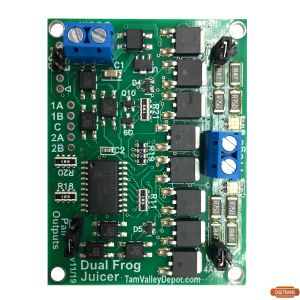Class 08 ActiveDrive SL For Dapol 0 Gauge. V17.07
Please spend a few moments to read these notes which have been produced so that you may obtain the maximum satisfaction from your new sound scheme.
The sounds should work perfectly when the decoder is fitted correctly. Individual locos may require some fine tuning that you can achieve with your DCC controller.
Engine and traction motor sounds recorded from different locomotives have been used in each variant and there are minor operational differences. Please refer to the correct instructions for your chosen variant when using these Notes.
Insulation
The Dapol 08 PCB has components which are very close to the decoder when fitted. There should not be a problem with this in normal use, but I strongly suggest covering these components with a strip of insulating tape before installing the decoder ‘just to be sure’.
When inserting the decoder, ensure that the black 21 pin socket is uppermost.
What is ActiveDrive?
This is a system developed to allow more prototypical sounds to be deployed across a wide range of operating conditions.
The sounds have been programmed in such a way that you, the user, may change the way that the sounds respond to your driving style or needs. This avoids the need for reprogramming and all the additional costs that would imply.
Engine Start Up.
Fuel is transferred to a header tank with a pump prior to starting if required. F14 has the sound of this pump which can be played before switching on the main engine sounds.
I have separated this from the start up sounds so that you can choose to use it or not.
Warm Start
F1 will crank and start the engine which will then settle down into Idle
Cold Start
Engage F5 before starting the engine with F1. The duration of engine cranking will be increased. F5 can be disengaged at any subsequent time.
Driving your model.
It is normal for the control lever on a real Class 08 to get to ‘Notch 2’ before the engine sound changes. This is due to the gearing, the tick-over speed and the way that the generator is set up. This means that when lightly loaded a Class 08 can be moved without the engine note increasing. This sound project provides a couple of ways to simulate this.
Opening the throttle modestly will allow the model to move without engine ramping. F5 will change the exact characteristics of what happens with your style of driving, normally delaying the power ramp-up sounds.
You can, of course, also use the well proven ZIMO feature on F6 to ‘hold’ the engine sounds in Fast Idle if you find that the engine ramping response is still too sensitive for your needs.
Throttle Response Scheme.
As supplied, the decoder will produce the sounds of a Class 08 with a train on the hook.
After the start-up routine the loco will stand with the diesel engine, the Prime Mover (PM), ticking over at idle.
The sounds will respond to the throttle control in the following way:
Select speed step 1. The brakes will release, the PM will increase power to get the loco moving, and will continue until at higher speed, a further ramp up will be initiated until the final high speed running sounds begin. The precise speed steps will depend upon your model, so I suggest you make a note of the actual figures for your later use.
The sounds will spool down at similar points on deceleration.
The model can be driven in this way without ever needing to use any control other than the throttle.
For those of you who prefer something more immersive, in this custom version there are extra control features to further enhance your driving pleasure.
Coasting
No matter what actual speed your model is travelling at, or which engine note range is playing, reducing the throttle by 10 speed steps (of 128) will spool down the engine sounds to ‘Coasting’
The coasting sound will continue until you accelerate; at which point the sounds will change to those relevant to the current speed.
Alternatively, to force the engine to play idling sounds, or to avoid engine ramp up when pottering about the yard, use F6 at any time
Notch Down
During any driving sound ‘loop’, at any speed, it is possible to cause the engine power to spool down to the level immediately below. This is easily achieved by reducing the speed by one step only E.g., if the loco is playing power band 3 sounds, reducing speed with your throttle by one step will cause the sound to immediately spool down to the sound of power band 2, if in power band 1, it will spool down to idle.
Acceleration of one speed step or more will immediately ramp the sound back up to the higher power. So you can now, at any road speed, vary the engine note by reducing or adding a single speed step.
Heavy Train/Light Engine Mode Selection
The default setting is for ‘heavy train’. Inertia is high so acceleration (and deceleration) is restricted.
Activated by F5, Light Engine enables multi-function changes with one key. The switched features include reduced inertia setting to allow more rapid acceleration and engine sounds which accelerate differently.
F5 can be operated at any speed to give another way in which the engine sounds at a given road speed may be modified instantly.
The 08 has a top seed of 15mph, and the decoder has been set to a similar maximum speed. If you open the throttle gently, it is possible to drive with engine sounds only.
(To increase top speed, increase the value in CV5)
However, flicking the throttle wide open will cause the sound of the Traction Motors to sound before fading.
With a moving loco, try flicking the throttle open and some slow, gentle accelerations to gauge the difference, and use ‘Notch Down’ to bring another variation to the loco’s sounds
Note. This works best if you switch F5 on or off whilst the engine sounds are playing in idle. Once switched, you can leave it that way, but any further change should also be made with the engine sound again playing the idle loop. Just to be clear, the actual speed is unimportant, but the engine sound must be idling. You can achieve this in several ways as discussed above.
Dynamic Inertia
A combination of new features is included in the automatic operation of the throttle which will affect how the model responds to your control inputs.
The operation is identical in either ‘heavy’ or ‘light’ mode.
Put in simple terms, the wider you open the power controller, the quicker the engine sounds ramp up and for the first time on any decoder, the acceleration rate increases correspondingly.
What does this mean in practice?
If you use your controller’s throttle gently, with modest speed step increases, then the engine will rise and fall automatically and the model will accelerate according to the momentum setting. This is by default high for ‘heavy’ and low for ‘light’.
If however, you open the throttle rapidly, the engine will ramp up to full power and acceleration will be approximately 3 times quicker. This change in acceleration rate is variable and dependent upon throttle operation.
Note. Although this feature is enabled, the low top speed may make it difficult to spot the difference. (It’s much more obvious on mainline locos).
Brakes
F2 will give the sound of air brake applications. They can be ‘dabbed’ or held for varying length. The sound will respond accordingly.
Additionally, if the throttle is reduced beforehand, as a real driver would do before braking, a braking force will be applied which will actually slow the road speed of the model progressively, that is the brake force applied will continue to increase the longer F2 is held. Short dabs will provide speed trimming, held down continuously will result in a controlled ‘Emergency Stop’.
PowerCab users please note that the Horn/Whistle button operates the same sound/function as the F2 Key, but set as ‘momentary’. This facilities the precise operation of the brakes and should be used instead of F2.
Other systems may have F2 set to operate as ‘momentary’ by default, or can be set to do so.
If the Brake Key is latched on whilst at standstill, opening the throttle will operate the engine sounds (i.e. can be used to apply more ‘power’) but the loco will not move until the Brake key is released. This can be used to simulate brake testing before operations begin, or for systems checks on a load bank.
The Brake Key must be in the ‘disengaged’ state when you wish to depart.
Speed Lock
This feature allows the road speed to be locked whilst the throttle control is used to control the engine power sounds playing.
Accurately simulating the sound of a heavy train slowly climbing a gradient with engine at full power is as easy as depicting it coasting down a gradient with the engine at Idle with this single new feature.
Here’s how it works.
Engage the SpeedLock Key, (F7) to fix the model’s road speed temporarily. The throttle now directly controls the engine sounds only. Increase speed steps to apply more power, decrease speed steps to spool the engine down to lower power bands or to Idle.
Disengage the SpeedLock Key when you wish to return control of the model’s speed to the throttle.
Fuel Transfer Pump
Fuel is delivered to the diesel pump by gravity from a small header tank. Fuel is held in the main tank and must be transferred to the header tank by a hand pump in the cab. This pumping is typically needed before starting and at intervals to maintain sufficient fuel in the header tank. In later years, some locos were fitted with an electrical lift pump
F 14 provides the sound of the mechanical pump and can be used whenever required.
Train Brakes
The loco brakes are air operated so all 08s have a compressor fitted to provide pressure.
A variety of train brakes have been used on this class over their long working life.
Some had no train brakes fitted at all
Some had Vacuum operated train brakes either from new or fitted later. Needed for some coaching stock and ‘fitted freight’ wagons. A special Vacuum pump called an Exhauster was fitted to these locos.
Others had Air operated train brakes either from new or fitted later. Required for air braked stock movements. A second compressor was fitted to these locos.
So called ‘Dual Braked’ were equipped with both air and vacuum train brakes.
The outward signs are the number of cabinets fitted to accommodate the additional pumps required, above the side footplates and any pneumatic pipes fitted to each end of the loco.
You will need to research what was fitted to the loco you choose to model in the period you are recreating.
The sound project has sounds on-board for each option, so some may not be applicable in every case.
Lights
When used, one red lamp and one white lamp each over a buffer and illuminated at each end of the loco simultaneously was the norm for BR when shunting. These are operated by F20.
A directional top lamp is provided on the model, switched by F0 in the project.
A cab light is provided on F10.
All lamps have a ‘soft’ fade in or out to simulate tungsten bulbs, and exterior lamps have been dimmed to be closer to realistic illumination levels. (To make them brighter if you wish, increase the value in CV60).
Light switch sounds will accompany the switching on or off of each set of lamps.
Live Volume Control
Provided the sound is switched on and the ‘fade’ button is not active, it is possible to change the overall volume to suit changing needs.
Engage F27 and the sound levels will gradually reduce, eventually to silence
Engage F28 and the sound levels will gradually increase, eventually to maximum.
In each case, disengage the F key when the desired level is attained. Set F27 and F28 as ‘momentary’ if your DCC controller allows you to do so.
Note: If the volume controls appear to not function, check that F19, F27 and F28 are disengaged before making a further attempt.
Function List
|
F Key
|
Function/Sound
|
Latch/
Momentary
|
Sound ID
CV
|
Volume
CV
|
|
0
|
Directional Top Light
|
L
|
570
|
571
|
|
1
|
Sound On/Off
|
L
|
-
|
-
|
|
2
|
Brake Key (non-latching)
|
M
|
516
|
517
|
|
3
|
Toot
|
M
|
519
|
520
|
|
4
|
Toot Toot
|
M
|
522
|
523
|
|
5
|
Light Engine Mode
|
L
|
-
|
-
|
|
6
|
Coasting/Idle Key
|
L
|
-
|
-
|
|
7
|
Speed Lock
|
L
|
-
|
-
|
|
8
|
Engine Speed up
|
L
|
534
|
535
|
|
9
|
Flange Squeal
|
L
|
537
|
538
|
|
10
|
Cab Light
|
L
|
540
|
541
|
|
11 ON
|
Buffering up
|
L
|
543
|
544
|
|
11 OFF
|
Coupling/uncoupling
|
L
|
543
|
544
|
|
12
|
Spirax Valves
|
L
|
546
|
547
|
|
13
|
Wagons Taking up Slack
|
M
|
549
|
550
|
|
14
|
Fuel Transfer Pump
|
L
|
552
|
553
|
|
15
|
Exhauster (Vacuum Train Brakes)
|
L
|
555
|
556
|
|
16
|
Compressor
|
L
|
558
|
559
|
|
17
|
Guard’s whistle
|
M
|
561
|
562
|
|
18 ON
|
Cab Door Opened
|
L
|
564
|
565
|
|
18 OFF
|
Cab Door Closed
|
L
|
564
|
565
|
|
19
|
Fade All Sounds
|
L
|
-
|
-
|
|
20
|
Shunting Lights
|
L
|
|
|
|
21
|
Shunt Mode
|
L
|
-
|
-
|
|
22
|
Windscreen Wipers
|
L
|
679
|
680
|
|
23
|
Reserved
|
L
|
-
|
-
|
|
24
|
Reserved
|
L
|
-
|
-
|
|
25
|
Reserved
|
L
|
-
|
-
|
|
26
|
Reserved
|
L
|
-
|
-
|
|
27
|
Volume Down
|
M
|
-
|
-
|
|
28
|
Volume Up
|
M
|
-
|
-
|
It’s now down to your skill and knowledge to simulate any eventuality!
Paul Chetter
Lincoln
July 2017





